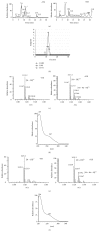A Novel Microbisporicin Producer Identified by Early Dereplication during Lantibiotic Screening
- PMID: 26346738
- PMCID: PMC4539421
- DOI: 10.1155/2015/419383
A Novel Microbisporicin Producer Identified by Early Dereplication during Lantibiotic Screening
Abstract
With the increasing need of effective antibiotics against multi-drug resistant pathogens, lantibiotics are an attractive option of a new class of molecules. They are ribosomally synthetized and posttranslationally modified peptides possessing potent antimicrobial activity against aerobic and anaerobic Gram-positive pathogens, including those increasingly resistant to β-lactams and glycopeptides. Some of them (actagardine, mersacidin, planosporicin, and microbisporicin) inhibit cell wall biosynthesis in pathogens and their effect is not antagonized by vancomycin. Hereby, we apply an efficient strategy for lantibiotic screening to 240 members of a newly described genus of filamentous actinomycetes, named Actinoallomurus, that is considered a yet-poorly-exploited promising source for novel bioactive metabolites. By combining antimicrobial differential assay against Staphylococcus aureus and its L-form (also in the presence of a β-lactamase cocktail or Ac-Lys-D-alanyl-D-alanine tripeptide), with LC-UV-MS dereplication coupled with bioautography, a novel producer of the potent microbisporicin complex was rapidly identified. Under the commercial name of NAI-107, it is currently in late preclinical phase for the treatment of multi-drug resistant Gram-positive pathogens. To our knowledge, this is the first report on a lantibiotic produced by an Actinoallomurus sp. and on a microbisporicin producer not belonging to the Microbispora genus.
Figures



Similar articles
-
A novel lantibiotic acting on bacterial cell wall synthesis produced by the uncommon actinomycete Planomonospora sp.Biochemistry. 2007 May 22;46(20):5884-95. doi: 10.1021/bi700131x. Epub 2007 May 1. Biochemistry. 2007. PMID: 17469849
-
Brominated Variant of the Lantibiotic NAI-107 with Enhanced Antibacterial Potency.J Nat Prod. 2015 Nov 25;78(11):2642-7. doi: 10.1021/acs.jnatprod.5b00576. Epub 2015 Oct 29. J Nat Prod. 2015. PMID: 26512731
-
Determining the structure and mode of action of microbisporicin, a potent lantibiotic active against multiresistant pathogens.Chem Biol. 2008 Jan;15(1):22-31. doi: 10.1016/j.chembiol.2007.11.009. Chem Biol. 2008. PMID: 18215770
-
Self-resistance mechanisms of actinomycetes producing lipid II-targeting antibiotics.Int J Med Microbiol. 2015 Feb;305(2):190-5. doi: 10.1016/j.ijmm.2014.12.015. Epub 2014 Dec 23. Int J Med Microbiol. 2015. PMID: 25601631 Review.
-
Epidermin and gallidermin: Staphylococcal lantibiotics.Int J Med Microbiol. 2014 Jan;304(1):63-71. doi: 10.1016/j.ijmm.2013.08.012. Epub 2013 Sep 4. Int J Med Microbiol. 2014. PMID: 24119540 Review.
Cited by
-
The untapped potential of actinobacterial lanthipeptides as therapeutic agents.Mol Biol Rep. 2023 Dec;50(12):10605-10616. doi: 10.1007/s11033-023-08880-w. Epub 2023 Nov 7. Mol Biol Rep. 2023. PMID: 37934370 Free PMC article. Review.
-
Heterologous Production and Structure Determination of a New Lanthipeptide Sinosporapeptin Using a Cryptic Gene Cluster in an Actinobacterium Sinosporangium siamense.J Microbiol. 2023 Jun;61(6):641-648. doi: 10.1007/s12275-023-00059-z. Epub 2023 Jun 12. J Microbiol. 2023. PMID: 37306831
-
Okichromanone, a new antiviral chromanone from a marine-derived Microbispora.J Antibiot (Tokyo). 2024 Jun;77(6):389-392. doi: 10.1038/s41429-024-00718-2. Epub 2024 Mar 22. J Antibiot (Tokyo). 2024. PMID: 38519549
-
Efficacious Analogs of the Lantibiotic Mutacin 1140 against a Systemic Methicillin-Resistant Staphylococcus aureus Infection.Antimicrob Agents Chemother. 2018 Nov 26;62(12):e01626-18. doi: 10.1128/AAC.01626-18. Print 2018 Dec. Antimicrob Agents Chemother. 2018. PMID: 30275083 Free PMC article.
References
Publication types
MeSH terms
Substances
LinkOut - more resources
Full Text Sources
Other Literature Sources
Molecular Biology Databases

